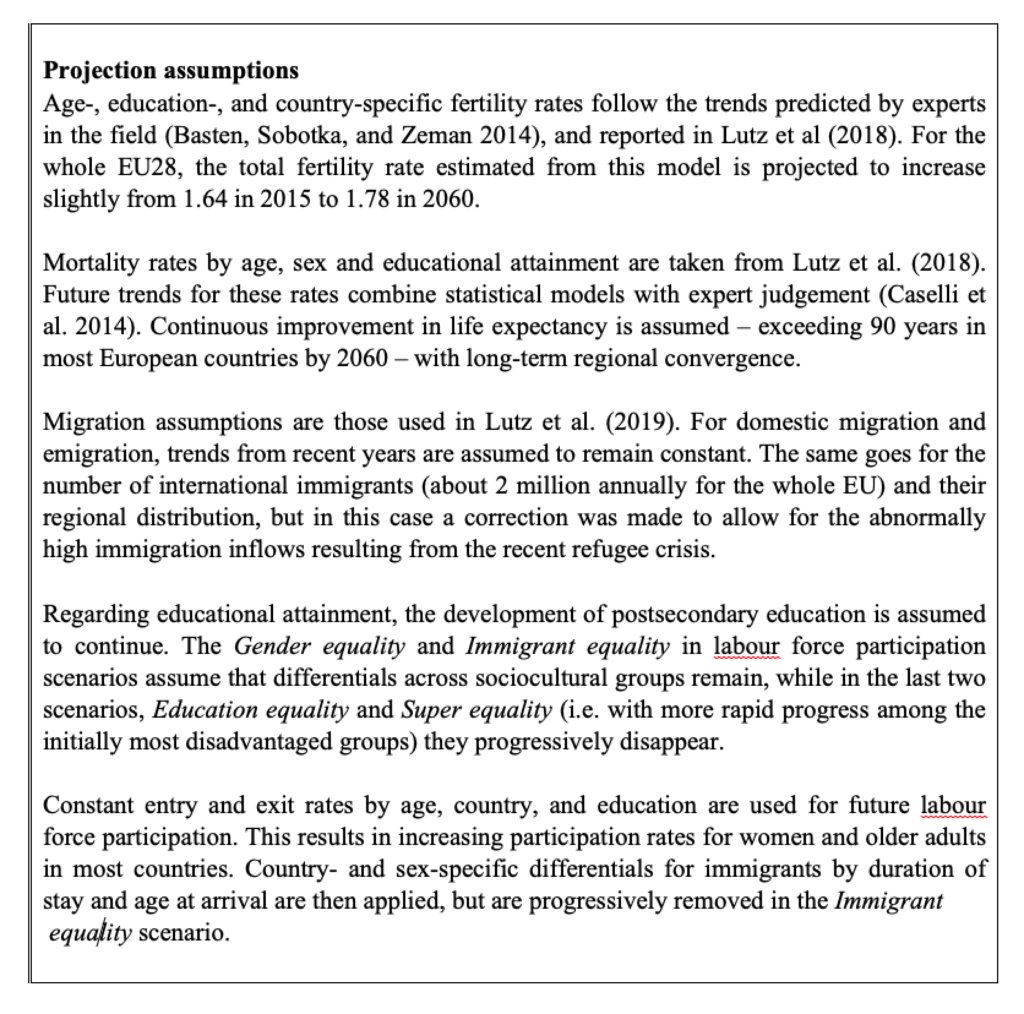Mitigating the labour market consequences of population ageing in the EU

Population ageing is inevitable, but its negative consequences on the future labour force of the European Union, up to 2060, could be greatly attenuated if women and immigrants were more present in the labour market (reaching the same levels as men and natives, respectively), and if educational levels were raised (because labour force participation increases with education). Using microsimulation methods, Guillaume Marois, Patrick Sabourin, and Alain Bélanger show that under the optimal scenario, where all of these favourable developments are combined, the economic future of EU28 does not appear so gloomy, after all. Whether this potential will be realized, however, remains to be seen.
Background
Following several decades of low fertility, the working-age population is or will soon be shrinking in many European countries, while the number of older adults will increase. Population ageing is unavoidable in Europe, but it need not affect, or only marginally, the size of its labour force: reducing differentials in labour force participation and educational attainment can have a very large impact, even greater than, for instance, immigration or population ageing.
Objectives
In a recent paper (Marois, Sabourin, and Bélanger 2019a), we assessed the impact of different policy-oriented scenarios on the future labour force of the European Union Member States up to 2060. More precisely, in addition to a reference scenario assuming the simple continuation of past trends, we constructed four alternative scenarios with the following characteristics:
- Gender equality in labour force participation, where women progressively increase their activity rates until, by 2050, they are as high as those of men living in the same country and having the same educational attainment;
- Immigrant equality in labour force participation, which assumes a convergence of labour force participation between immigrants and natives with a similar age-sex-education profile by 2050. This scenario shows the possible impact of efficient policies focused on better economic integration of immigrants, such as removing barriers to employment;
- Education equality, which removes the disadvantage in educational achievement for children of low-educated mothers and those with an immigrant background. Since education is a major determinant of labour force participation, this scenario reveals the strongest possible effect of targeted investments in education aimed at eliminating the barriers to educational attainment of the most vulnerable children;
- Super equality, which combines the assumptions on inequality reductions of the three previous scenarios.
We constructed these alternative scenarios using CEPAM-Mic (Bélanger et al. 2019; Marois, Sabourin, and Bélanger 2019b, 2019c), a sophisticated microsimulation model developed for the Center of Expertise on Population and Migration (CEPAM)¹. CEPAM-Mic can be used to project the population of EU28 member countries while controlling for as many as 13 different socio-economic and ethno-cultural dimensions, and to create scenarios combining different hypotheses on the future evolution of the components of population change. All scenarios share the same basic assumptions for fertility, mortality, and domestic migration (see below).

Results
Under the reference scenario, the labour force of the European Union is expected to decline by about 19 million by 2060, as shown in Figure 1a, falling from about 244.6 million workers in 2015 to 225.6 million in 2060. As the inactive population will grow because of increasing life expectancy and the entry into retirement of the baby-boom generation, the labour force dependency ratio (LFDR) ‒ the ratio of the inactive (including children and older adults) to the active population ‒ is projected to increase from about 1.08 in 2015 to 1.33 in 2060 (figure 1b). This scenario is similar to other labour force projections (Loichinger 2015; European Commission and Economic Policy Committee 2017).

The gender equality scenario yields a large positive impact on both the labour force size and the labour force dependency ratio. If the participation rates of women gradually reached those of men by 2050, the expected decline in the labour force would be reduced by about 50% compared to the reference scenario.
Removing inequalities in labour force participation for immigrants also yields a sizeable effect. Compared to the reference scenario, the expected decline in the labour force by 2060 would be reduced by 29%, (about 231 million workers vs. 225.6 million). In addition to increasing the number of workers, turning inactive immigrants into active ones, as we do in this scenario, reduces the increase in the LFDR by 22%, to 1.27 in 2060 vs. 1.33 in the reference scenario.
Removing inequalities in education has a smaller impact on the labour force size: although an increase in education positively affects participation rates, future cohorts become smaller, because more educated women also tend to have fewer children. The positive impact of this scenario is more apparent on the labour force dependency ratio (LFDR), which would increase only to 1.28 vs 1.33 under the reference scenario. In addition, since education is highly correlated with productivity, the education equality scenario could markedly improve the general economic situation of the EU (not shown here). Indeed, this scenario yields a sharp increase of 61% in the number of highly educated workers, compared to only 24% in the reference scenario, thus significantly changing the educational profile of the future labour force.
The best that we can hope…
Finally, combining the positive assumptions of the three previous “what-ifs” (Super equality scenario) results in a labour force of about 236 million in 2060, which is only 4% lower than the current (2015) size. In 2060, the labour force would be similar in size to that of 2008. Although this scenario cannot prevent the expected increase in the LFDR, it would significantly reduce the pace of its growth, with a ratio of 1.16 in 2060, only 0.08 higher than that observed in 2015. Two-thirds of the impact of population ageing would thus be offset (compared to the reference scenario), in addition to preventing a significant labour force decline.
Although population ageing is an outcome largely driven by past demographic behaviours, this research shows that its broad consequences, in terms of labour force size and labour force dependency ratios are not set in stone.
References
Basten Stuart, Sobotka Tomas, and Zeman Krystof. 2014. “Future Fertility in Low Fertility Countries.” In World Population and Human Capital in the 21st Century, edited by Wolfgang Lutz, William P. Butz, and Samir KC, 39–146. Oxford: Oxford University Press.
Bélanger Alain, Sabourin Patrick, Marois Guillaume, Van Hook Jennifer, and Vézina Samuel. 2019. “A Framework for the Prospective Analysis of Ethno-Cultural Super-Diversity.” Demographic Research 41 (11): 293–330.
Caselli Graziella, Drefahl Sven, Wegner-Siegmundt Christian, and Luy Marc. 2014. “Future Mortality in Low Mortality Countries.” In World Population and Human Capital in the 21st Century, edited by Wolfgang Lutz, William P. Butz, and Samir KC, 226–72. Oxford, UK: Oxford University Press.
European Commission, and Economic Policy Committee. 2017. “The 2018 Ageing Report: Underlying Assumptions and Projection Methodologies.” European Economy. Institutional Papers 065. Brussels: European Commission.
Lutz, Wolfgang, Goujon Anne Valia, KC Samir, Stonawski Marcin, and Stilianakis Nikolaos. 2018. “Demographic and Human Capital Scenarios for the 21st Century: 2018 Assessment for 201 Countries.” Luxembourg: Publications Office of the European Union. https://doi.org/10.2760/41776.
Lutz, Wolfgang et al. 2019. Demographic Scenarios for the EU – Migration, Population and Education. Luxembourg: Publications Office of the European Union.
Loichinger, Elke. 2015. “Labour Force Projections up to 2053 for 26 EU Countries, by Age, Sex, and Highest Level of Educational Attainment.” Demographic Research 32 (15): 443–86. https://doi.org/10.4054/DemRes.2015.32.15.
Marois, Guillaume, Patrick Sabourin, and Alain Bélanger. 2019a. “How Reducing Differentials in Education and Labour Force Participation Could Lessen Workforce Decline in the EU-28.” Demographic Research 41 (6): 125–60.
Marois, Guillaume, Patrick Sabourin, and Alain Bélanger. 2019b. “Implementing Dynamics of Immigration Integration in Labour Force Participation Projection in EU28.” Population Research and Policy Review.
Marois, Guillaume, Patrick Sabourin, and Alain Bélanger. 2019c. “Forecasting Human Capital of EU Member Countries Accounting for Sociocultural Determinants.” Journal of Demographic Economics 85 (3).
¹The Centre of Expertise on Population and Migration (CEPAM) is a joint research project of the International Institute for Applied Systems Analysis (IIASA) and the Joint Research Centre (JRC) of the European Commission.